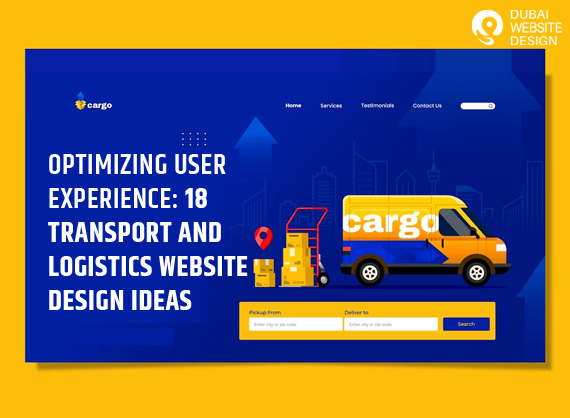Enhance user experience and operational efficiency with these 18 transport and logistics website design ideas. Boost customer satisfaction and stand out in the industry. An effective and user-friendly website is crucial for luring and keeping consumers in the fiercely competitive transport and logistics sector. A professionally designed website may have a big influence on a business’s performance, client happiness, and reputation.
We will discuss the website design for logistics business and its emphasis on improving user experience and operational effectiveness.
Intuitive Navigation: Simplifying the User Experience
Easy navigation is important when designing a website for a logistics or transportation company. Users may discover the data they want, such as services, tracking tools, contact information, and shipment schedules, quickly by using a clear and well-organized menu.
Accessibility Throughout Devices Using Responsive Design
In light of the widespread use of mobile devices and tablets, responsive web design is essential. The user experience is improved and a wider audience is reached by making sure the website is accessible and runs well on many devices.
Real-Time Tracking: Giving Users Control
Real-time tracking capabilities enable clients to follow their shipments or deliveries right away. Enhancing transparency and fostering customer trust through the provision of shipment updates, present location, and projected arrival timings.
Simple Online Booking: Simplifying Procedures
Online booking alternatives that are simple to use should be available on a reliable website design for logistics business. By putting in place a user-friendly booking system, operations may be improved and consumers’ experiences made simpler.
Visualizing Routes and Coverage on Interactive Maps
Interactive maps that depict delivery coverage, routes, and service locations are attractive and educational. Users may quickly discover the areas that your business serves, making it easier for prospective customers to make decisions.
Integrating Customer Support: Establishing Credibility
Customers may quickly seek assistance by using customer support features like live chat or a special support website, which are integrated. Quick replies to inquiries increase client satisfaction by fostering confidence.
Using Effective Contact Forms to Promote Engagement
Contact forms that are optimised, have the right fields and have calls-to-action that attract client enquiries and comments. The creation of leads is facilitated and communication is streamlined by a well-designed contact form.
Safety and Security Information: Assuring Reliability
Security and safety are top priorities in the transportation and logistics sector. Potential clients are given confidence by information regarding safety precautions, certifications, and quality standards shown.
Case Studies and Testimonials: Showcasing Expertise
Included client testimonials and case studies highlight your business’s know-how and successful project executions, enhancing credibility and drawing in new clients.
Sections that Highlight Services: Highlighting Specializations
Users may get a thorough picture of your capabilities via specialised sections showcasing certain services or solutions provided, such as international shipping, warehousing, or rapid delivery.
API Integration: Increasing Functionality
Integrating APIs, such as tracking systems for shipping companies or e-commerce platforms, may improve the functioning of websites and give users a smooth experience.
Support for Multiple Languages: Serving International Clientele
The availability of multilingual assistance can improve the website’s usability and accessibility for businesses with global customers.
Optimized Page Loading Time: Lower Bounce Rates
Fast page loads are crucial for keeping users on your site. Keeping bounce rates to a minimum enhances user experience and keeps potential buyers on the site.
User-Centric Content That Is Educational and Entertaining
Engaging material, such as blog posts, educational articles, and FAQs, improves user engagement and positions your business as a trustworthy industry resource.
Highest Quality Images: Showing Fleet and Facilities
Users can better visualise the capabilities and infrastructure of your business by viewing high-quality pictures and videos of your warehouses, facilities, and transportation fleet.
Initiatives for Energy Efficiency: Showcasing Sustainability Efforts
If you place a high priority on sustainability and energy efficiency, customers that care about the environment could be interested in your business’ eco-friendly initiatives.
Integration Of Mobile Applications: Improving Usability And Convenience
For logistics and transportation, consider including a mobile app with your WordPress website development. Customers may have access to supplemental services like push alerts, simple tracking data access, and simplified booking choices through a specialist app. This seamless connection improves user comfort and accessibility, which raises client happiness and loyalty.
Action-Inspiring Buttons to Boost Conversions
To increase conversions, strategically position large call-to-action (CTA) buttons on your website. Professionally designed CTAs direct visitors towards performing the required actions, either it’s for reserving a service, obtaining a quote, or contacting customer care. It strengthens conversion rates and lead generation.
In A Nutshell
WordPress website development plays an essential role in a flawless customer and company experience in the intense logistics and transit industry. The visitor’s engagement is improved by the mix of straightforward navigation, responsive design, real-time tracking, and interactive elements. Additionally, it increases operational effectiveness.
Companies may win the audience’s confidence and credibility by performing effectively, placing safety first, and disseminating clear information. To set yourself apart from the competition, use these website design suggestions for logistics and transportation. Encourage business growth and new consumer acquisition.

